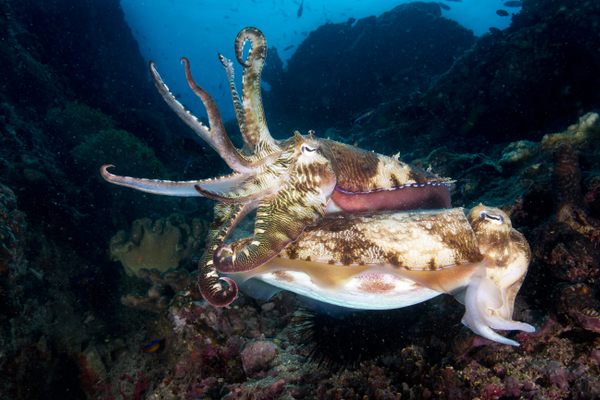This Fish’s Propensity for Deafening Orgies Is Both Its Strength and Its Weakness
A single male Gulf covina is louder than a jet engine.
Do your neighbors—how to put this delicately—get loud when they bump uglies? Do they rattle the mirrors? Are they, you might say, aggressive cuddlers?
Hey, it could be worse! At least you don’t live near the spawning grounds of the Gulf corvina, a shiny fish that lives off the coast of Mexico. Individual male members of the species produce a rumbling courtship call noisier than a jet engine. En masse, corvinas make “among the loudest animal sounds recorded in aquatic environments,” researchers write—which is one reason we should make sure to protect them.
Biologists have recorded the machine-gun sound of the Gulf corvina — the loudest known fish https://t.co/XCR28IGhgS
— Pittsburgh Post-Gazette (@PittsburghPG) December 21, 2017
In 2014, two marine scientists, Brad Erisman and Timothy Rowell, took a sonic survey of the fish, heading down to the Gulf of California’s Colorado River Delta to listen in on the annual spawning. In a recent paper in Biology Letters, they present some of their findings.
The sex call of a single male corvina, they write, is “the loudest [sound] recorded in a marine fish.” It’s about half a second long, and comprised of a series of rapid pulses, which the fish make by vibrating special muscles around their swim bladders. To humans, it sounds a little like the rat-a-tat of a machine gun, or, if you’re feeling more musically generous, like someone playing the washboard.
It comes in at an average of 177 decibels, beating out a number of better-known oceanic showstoppers, including the whistle of the bottlenose dolphin (138 decibels) and the song of the humpback whale (169). (A human scream, if you were wondering, tops out around 129 decibels.)
When more than a million of these guys get together—as they do once a year, in the spring, along an eighteen-mile stretch of the delta—things get really raucous. At that point, the researchers write, the chorusing fish “can elevate the local soundscape 21 times louder than ambient levels.” It gets noisy enough that the sound “reverberate[s] through the hulls of small, fibreglass fishing boats,” and vastly exceeds the daily recommended noise exposure level for many of the fish’s mammalian neighbors, including sea lions and dolphins.
In a blog post from 2013, Erisman describes the sound, even above the water, as “like the biggest swarm of bees you ever heard.” “At times… I had to shout to talk to the rest of the team,” he writes.
The calls may successfully woo female fish, but the spectacle also attracts predators. The aforementioned sea lions and dolphins also enjoy the feast enough that they risk hearing damage to feed at the edges of the spawning area, like a hungry student darting in and out of a cafeteria food fight to use the peripheral vending machines. More troublingly for the corvina population, fishing boats follow the sound, and pull out whole swaths of the orgy. “A single [boat] with one net can catch 2 tons of corvina within minutes,” the researchers write.
(1/3) ~6000 MT of Gulf Corvina R harvested per yr; we use an #echosounder 2 study the pop https://t.co/YaYh3f9tCo pic.twitter.com/WUBMv2B5nm
— GoC Marine Program (@GCMarineProgram) September 11, 2016
Such “intense, persistent fishing activity… has greatly reduced the size of the adult population,” they continue. Indeed, the Gulf corvina has been deemed “vulnerable” by the International Union for Conservation of Nature, who report that the average length of the fish has been decreasing.
But one silver lining is that the racket also provides a unique opportunity to keep tabs on the fish. In a different article from earlier this year, published in Scientific Reports, Rowell, Erisman, and other collaborators detail how, by combining two different sound survey methods, they were able to get an estimate of the size of the spawning, which has eluded previous surveys. Having this information, they write, could help “inform the quota system” that determines how many corvina can be caught.
This is only fair for such a talented animal, whose sex volume accomplishments, the researchers said in a statement, should grant it “increased appreciation and conservation.” Hear, hear.










Follow us on Twitter to get the latest on the world's hidden wonders.
Like us on Facebook to get the latest on the world's hidden wonders.
Follow us on Twitter Like us on Facebook